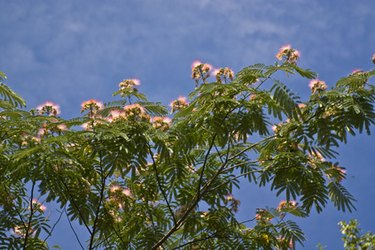
The mimosa tree (Albizia julibrissin) is a fast-growing tree with fragrant, lacelike blossoms. Not native to the United States, the mimosa tree has spread significantly in the southern portions of the country and has even been classified as an invasive species. The tropical effect and dappled shade created by the mimosa tree make it a popular patio or indoor plant. The downfall of the mimosa tree is its short life span (usually around 10 to 20 years) and its problem-prone nature. However, with the right care and proper fertilization, the mimosa tree has a lot of potential in any yard.
Step 1
Take a soil sample from the area underneath your mimosa tree to your local USDA or university cooperative extension for testing. Soil testing is important, because it is the only way of knowing the specific nutrient composition (and deficiencies) of your soil. There are also home test kits available that work decently well and are fine for most residential uses. Once you have your soil test information, you can decide what is lacking and you can work from there to correct any deficiencies.
Video of the Day
Step 2
Choose a slow-release tree fertilizer. Mimosa trees respond best when they are fertilized once a year with a slow-release fertilizer. The term slow release indicates that the fertilizer breaks down over an extended period, usually a few months. This system is ideal for two reasons. First, a slow-release fertilizer carries a lower chance of burning the tree. Secondly, the slower release system allows the tree to take in more nutrients as they are needed throughout the growing season. It is important to get a fertilizer made for trees or shrubs as opposed to other varieties of slow-release fertilizer because the chemical contents are different.
Step 3
Choose a time to apply the fertilizer. Pick a day in the earlier part of the growing season that is not too hot or cold. It is also important to pick a day that is not followed by a period of heavy rain, which has the potential to wash away some of the fertilizer.
Step 4
Apply your slow-release tree fertilizer according to the package directions. Almost all slow-release tree fertilizers are pelletized or granular, meaning that they exist in a small solid form that is simply applied to the ground around the mimosa tree. Water will soak these nutrients into the ground where the mimosa will absorb them over time. The fertilizer will come with an application guide to help you determine how many lbs. of fertilizer to use based on the size of the tree (usually measured in truck diameter). Other slow-release fertilizers may be in the form of a fertilizer stake that you just pound into the ground or even liquid which needs to be applied with a sprayer.
Step 5
Water your mimosa tree after applying the fertilizer. The water will help prevent a large buildup of salts that can cause fertilizer burn (a condition that causes browning or death of tree limbs). In addition, the water, especially in granular fertilizers, is necessary to help the fertilizers penetrate into the soil to the root zone of the mimosa tree where they can be absorbed.
Tip
If your mimosa tree is planted in a container and kept inside as a houseplant, use a balanced fertilizer (10-10-10) and fertilize once a month during the growing season.
Warning
Always follow the fertilizer handling and storage directions carefully to avoid any health complications.
Video of the Day